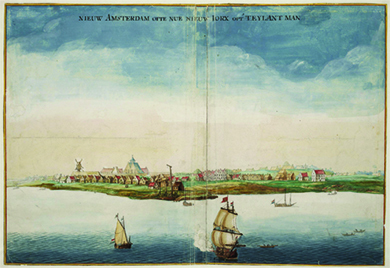| << Chapter < Page | Chapter >> Page > |
The outrages committed by traders, combined with the seemingly unstoppable expansion of English settlement onto native land, led to the outbreak of the Yamasee War (1715–1718), an effort by a coalition of local tribes to drive away the European invaders. This native effort to force the newcomers back across the Atlantic nearly succeeded in annihilating the Carolina colonies. Only when the Cherokee allied themselves with the English did the coalition’s goal of eliminating the English from the region falter. The Yamasee War demonstrates the key role native peoples played in shaping the outcome of colonial struggles and, perhaps most important, the disunity that existed between different native groups.
Charles II also set his sights on the Dutch colony of New Netherland. The English takeover of New Netherland originated in the imperial rivalry between the Dutch and the English. During the Anglo-Dutch wars of the 1650s and 1660s, the two powers attempted to gain commercial advantages in the Atlantic World. During the Second Anglo-Dutch War (1664–1667), English forces gained control of the Dutch fur trading colony of New Netherland, and in 1664, Charles II gave this colony (including present-day New Jersey) to his brother James, Duke of York (later James II). The colony and city were renamed New York in his honor. The Dutch in New York chafed under English rule. In 1673, during the Third Anglo-Dutch War (1672–1674), the Dutch recaptured the colony. However, at the end of the conflict, the English had regained control ( [link] ).

The Duke of York had no desire to govern locally or listen to the wishes of local colonists. It wasn’t until 1683, therefore, almost 20 years after the English took control of the colony, that colonists were able to convene a local representative legislature. The assembly’s 1683 Charter of Liberties and Privileges set out the traditional rights of Englishmen, like the right to trial by jury and the right to representative government.
The English continued the Dutch patroonship system, granting large estates to a favored few families. The largest of these estates, at 160,000 acres, was given to Robert Livingston in 1686. The Livingstons and the other manorial families who controlled the Hudson River Valley formed a formidable political and economic force. Eighteenth-century New York City, meanwhile, contained a variety of people and religions—as well as Dutch and English people, it held French Protestants (Huguenots), Jews, Puritans, Quakers, Anglicans, and a large population of slaves. As they did in other zones of colonization, native peoples played a key role in shaping the history of colonial New York. After decades of war in the 1600s, the powerful Five Nations of the Iroquois, composed of the Mohawk, Oneida, Onondaga, Cayuga, and Seneca, successfully pursued a policy of neutrality with both the English and, to the north, the French in Canada during the first half of the 1700s. This native policy meant that the Iroquois continued to live in their own villages under their own government while enjoying the benefits of trade with both the French and the English.

Notification Switch
Would you like to follow the 'U.s. history' conversation and receive update notifications?